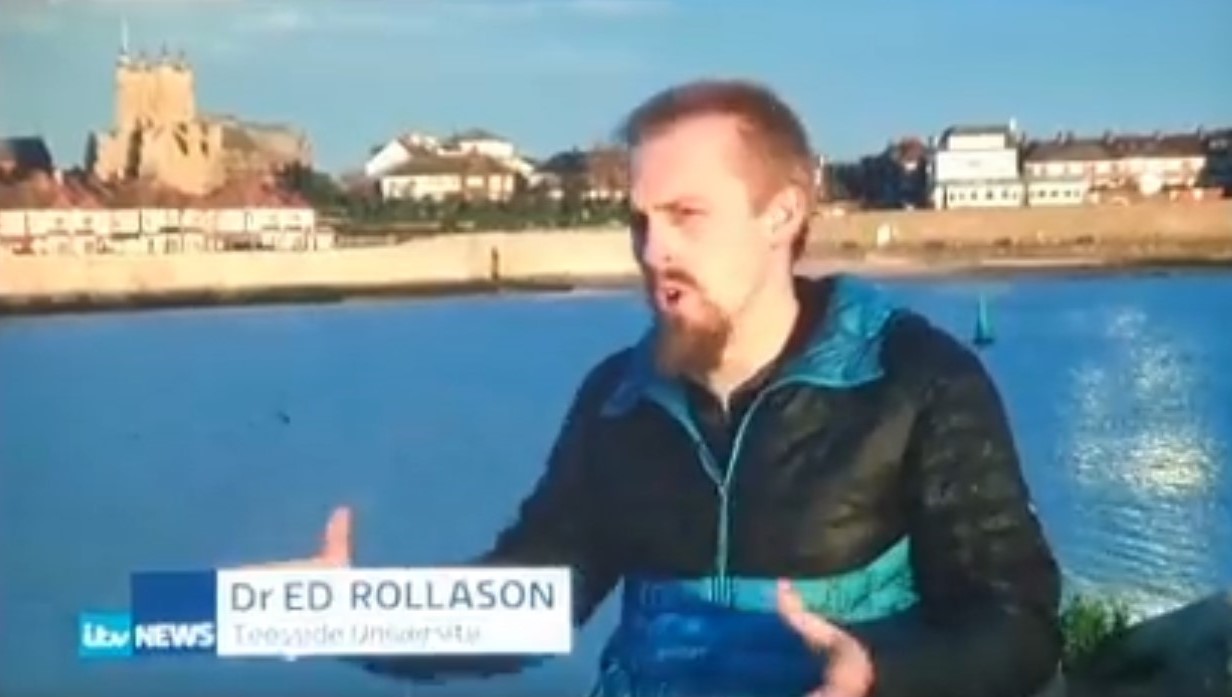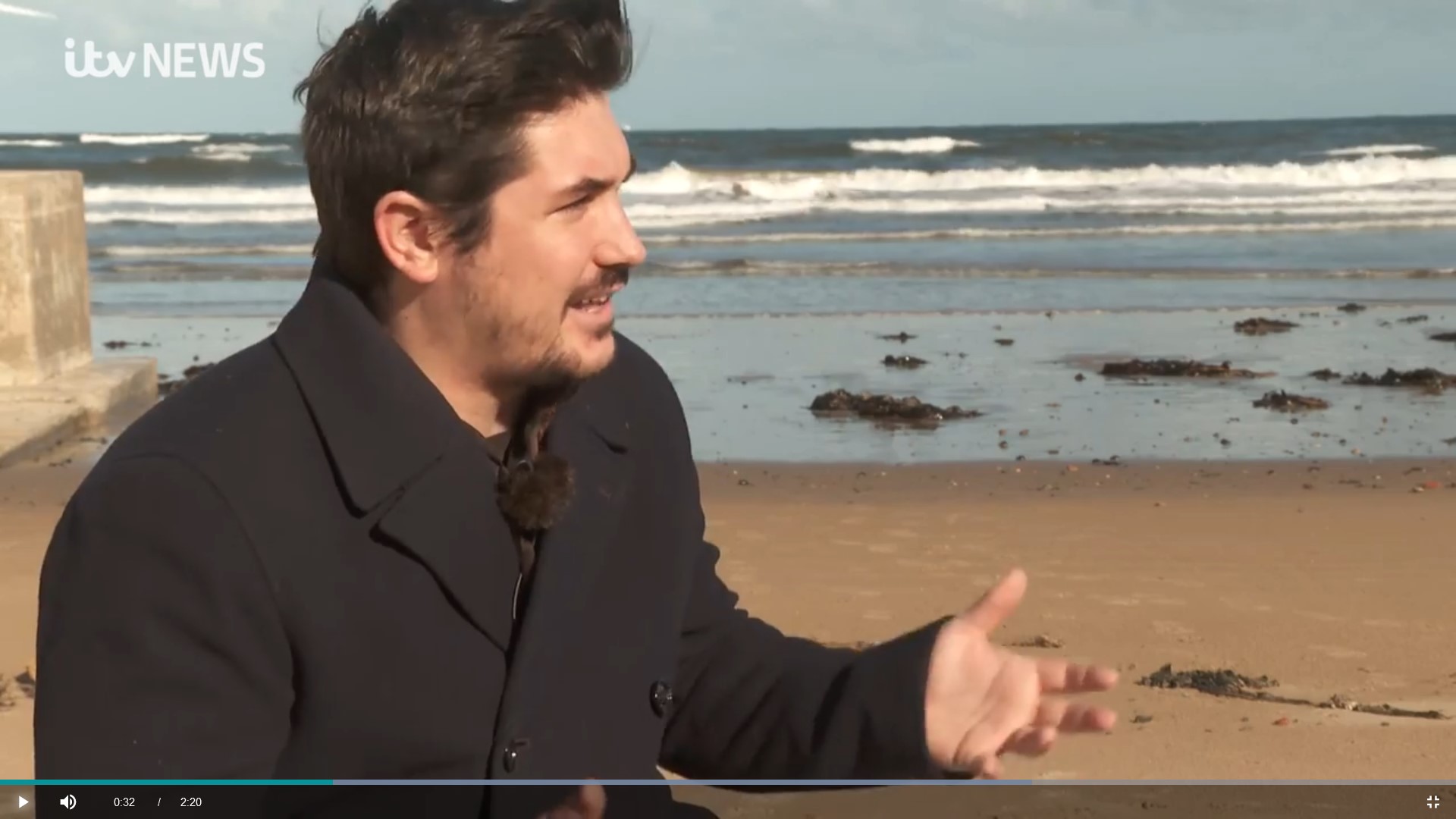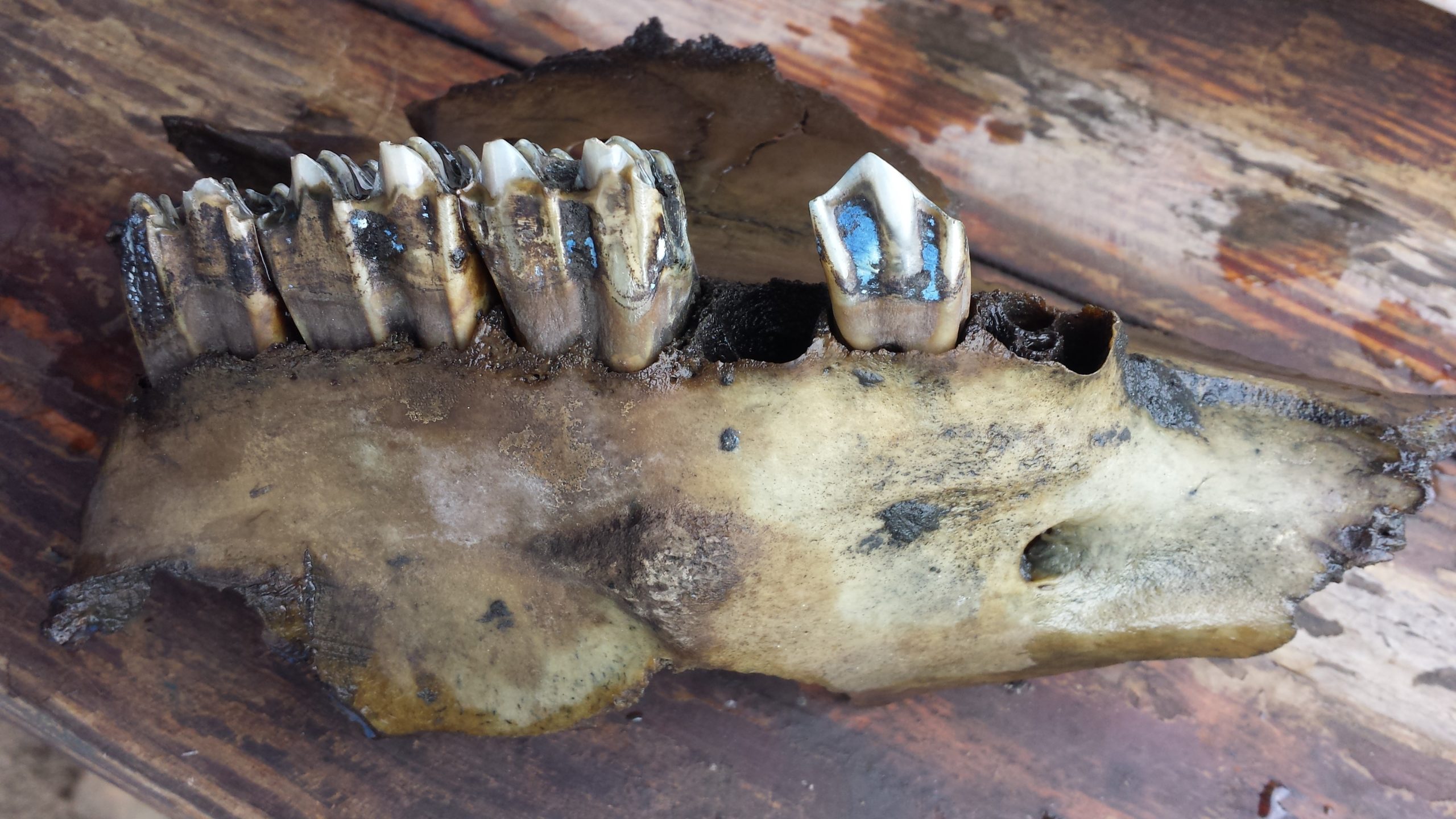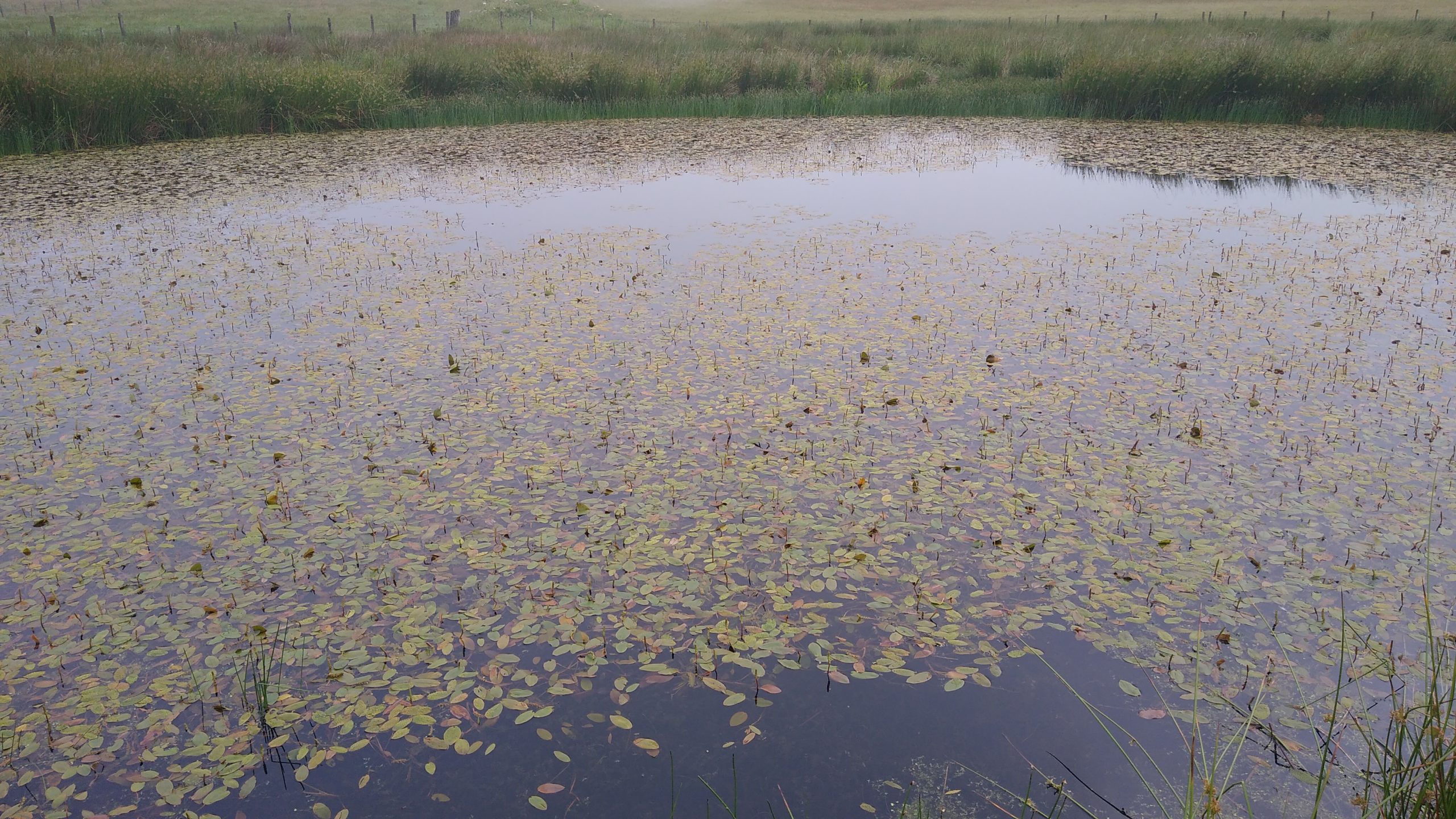Dr Ed Rollason shared his expertise about coastal flood risk on a ITV News report:
Tees Valley Youth Climate Summit 2021
Climate researchers, members of the Earth Ecology and Environment research collective led the organisation of the first Tees Valley Youth Climate Summit with colleagues from across the university.
The summit was a success widely relayed in the local press, for example in the Northern Echo.
There are already talks of a 2022 summit…
Dr Jamie Bojko and PhD Candidate Amy Burgess in the news
Dr Jamie Bojko and Amy Burgess shared their expertise in an interview with ITV, following the crustacean mass kill observed on Teesside coastline. The incident is being investigated by the Environmental Agency and CEFAS. You can catch up with the interviews following this link to ITV.com: Why are hundreds of crabs washing up dead on Teesside’s beaches?
The news and the interview was widely relayed in the press.
Promotions
We are proud to announce that four members of the Earth, Ecology and Environment research collective have been promoted to senior lecturer:
Dr Lisa Baldini, Senior Lecturer in Environmental Science (Research & Innovation)
Dr Danny McNally, Senior Lecturer in Human Geography (Research and Innovation)
Dr Jamie Bojko, Senior Lecturer in Disease Ecology (Research and Innovation)
Dr Ambroise Baker, Senior Lecturer in Ecology (Research and Innovation)
We can expect many more promotion to come in the coming years following the University’s research path, of the academic progression framework.
Online Exhibit: Digging up 3D Memories
This summer, TUBA were hard at work with 3D scanning for the Digging up Memories – Making Connections online exhibit that has now officially gone live! You might even have seen snippets yourself or read about it in the recent Teesside University press release. And so, we thought it’d be nice to give a little behind-the-scenes of this amazing opportunity.
How does 3D scanning actually work? Well, there are lots of different types of 3D scanners, all with their own applications and uses. For this exhibit, we used a structured light scanner (SLS), which works by projecting a tightly calibrated set of patterns onto an object. The pattern changes shape as it falls onto an object, resulting in 3D measurements. This process takes a full, closed scan of the camera view, which we then apply a texture to by applying red, blue and green light filters:
How can we use this in our work with Vindolanda? As you may have noticed in some of our previous blog posts, we’re big fans of 3D here, including animal and human heads on pikes, and the Locomotion. We’ve even published on 3D scanning of ox crania used in target practice, and have some further outputs on their way. The key outcome from 3D scanning for the museum environment is access. How often have you visited a museum and though “hey, that’s a pretty cool object, I wanna look closer”? 3D scanning provides a digital model of the object that you can freely zoom in and out or rotate around, which is.. well, pretty neat! However, we can then run some bespoke processes to make these 3D printable. That’s right – you can properly get hands-on with highly accurate replicas of delicate and fragile museum objects!
So where does this lead us? Well, over the years, we’ve been partaking in several exhibits on the 3D scanning, chemical and microbial work we’ve been undertaking at Vindolanda. Following the success of these, we were invited to Vindolanda over the summer to explore the suitability of 3D scanning a wide range of wooden objects. To say we were excited and proud of this opportunity is an understatement!
There is such a fabulous range of wooden artefacts available for your viewing from the comfort of your sofa, so please do look at these either on Sketchfab or better yet, on the Digging up Memories exhibit on the Vindolanda website! Here, you can find more information, videos and commentary on each object plus the 3D models. Some of these are incredibly rare, such as the only conserved wooden toilet seat in Britain, the cherry wood saddle stiffener, or the wooden trowel with mortar still stuck to it!
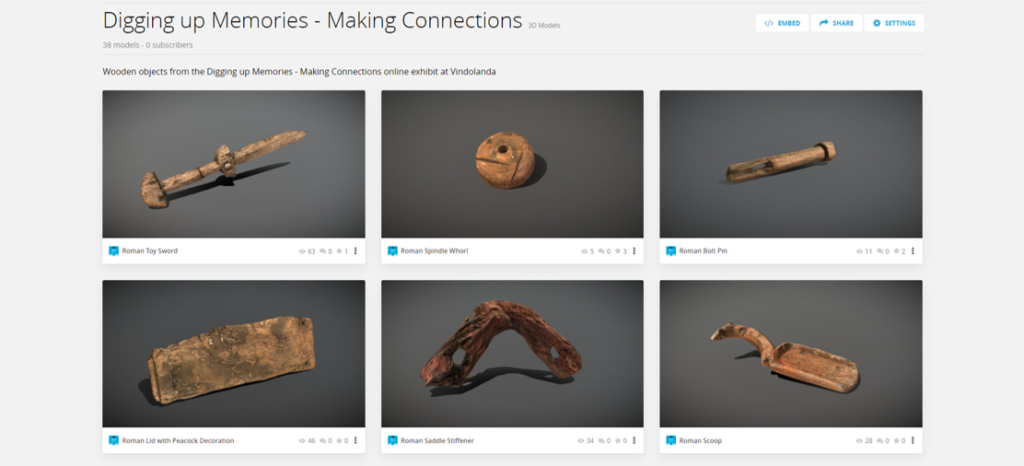
We do have a couple personal favourite objects, of course. The wooden toy sword is an excellent artefact because it really demonstrates that the military took their families with them to Vindolanda, rather than the typical focus on conflict and fighting. The pepper pot is also great because of how well the 3D scanning came out – we had anticipated this to be poor because it’s a very cylindrical object that normally doesn’t facilitate 3D scanning but there was just enough of an irregular morphology to stitch together and texture beautifully. Atto’s Workbench is also a fantastic object but the sheer size and lack of thickness meant it took more scans and time than any other object we’ve scanned in order to fully capture and register together. This was well worthwhile because you can actually feel the hammer impressions on the 3D printed version!
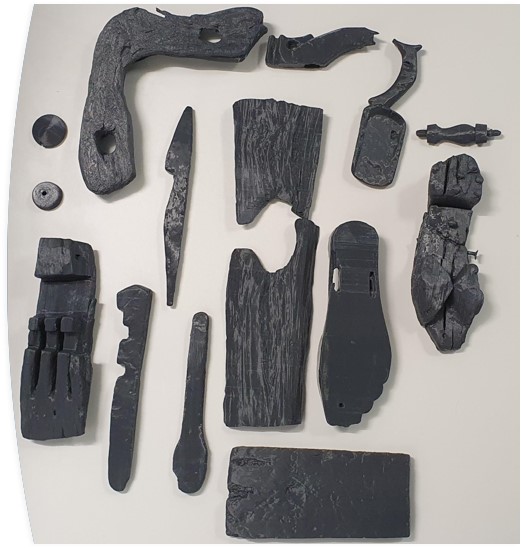
And that brings us nicely to our final point – hopefully over the coming days, weeks and months, you’ll have the opportunity to visit Vindolanda and get hands-on with some highly accurate 3D printed versions of a wide selection of these wooden artefacts! We cannot recommend this enough; this evokes such a different set of emotions and leaves an experience that lingers for a long time. Who knew that something as banal as opening and closing a pepper pot lid could be so captivating!
How did all of this come about? Purely thanks to so many people involved, coming together for this collaborative effort, with Vindolanda Trust and Dr Anneke Hackenbroich driving this project forward. Our utmost thanks to them for inviting us to be part of this special exhibit, we’re all thrilled here to see it come together as I’m sure all are at home too!
Lastly, keep an eye out for updates to the Digging up Memories – Making Connections exhibit, with more objects being added at the start of November and December.
TUBA
Climate Change and Maize Farming in Belize – Reflections on my PhD field work
PhD Raquel Chun shares reflection from her field work:
“Now in 2021, data collection is starting up again but with extra careful planning and adhering to strict protocols to ensure both myself and my farmers are safe. I have been out in 5 farms already doing soil collecting and conducting 4 interviews. My farmers are happy to see me again but they are also very concerned about Covid-19. All of our lives are different from the last time we spoke in 2019.
Reminiscence
As I progress- albeit a bit slowly – on data analysis, the memories of my adventures during fieldwork come back with surprising clarity. In 2019, I trudged barefoot across a river, tripped over farm debri, drove – slipping and sliding in my 2-wheel drive, sturdy little SUV- over muddy roads and partook in simple, local meals over a period of 6 months in southern Belize.
First of all, my project under the Global Challenges Research Fund Centre for Doctoral Training at Durham University and co-supervised by Dr Lisa Baldini at Teesside University is to research the impact of climate change in the decision making of indigenous Maya farmers in three villages in southern Belize. This involves monitoring changes in weather and climate utilizing weather station and historical data, conducting ethnographic interviews with Maya farmers as well as soil monitoring and crop yield measurements. My research seeks to offset the lack of information on the impact of climate change on smallholder farmers by studying the impact of changing weather patterns on the decision making of Belizean Maya farmers in the Toledo District over the long and short term.
My first year of data collection in 2019 started with a metaphorical bang. Initially, I was arranging meetings with the local leaders of three Maya communities as per cultural protocol in order to introduce the project and find farmers who were willing to participate. The community leaders of the first community I approached were very eager for their farmers to participate in my study so I was off like a shot, arranging meetings with interested farmers and planning farm visits to start soil sampling with the knowledge I had gathered since I had begun my studies in February 2019. The data collection was a challenging yet fulfilling journey that yielded new friendships and knowledge.
As I started this journey, I was unaware of how much it would truly impact my life and help me learn more about the lives of smallholder Maya farmers. Although I am an indigenous Maya woman, I grew up in a more urban setting, 3 miles from the capital city of Belmopan. Therefore, as I went along my fieldwork visits, I learnt about local beliefs surrounding farming as well as the struggles these families go through as they make their living. It made me gain more perspective on the issue of climate change and how it affects the livelihoods of the most vulnerable people. I have been welcomed with open arms and a lot of curiosity due to the fact that I am a Mopan Maya female studying for a PhD in the field of agriculture and climate change which is mostly foreign to them as well. This dynamic has made for some interesting conversations with farmers’ and their families.
At the end of 2019, I had two data collection rounds doing soil sampling of farms, conducting interviews with farmers and taking crop yield measurements after harvest.
COVID19 Pandemic – impact on my work
Well we all know what happened in 2020 with a global pandemic almost bringing the world to a standstill. This, of course, included my fieldwork which was both a blessing and a curse. In April of 2020, I became the mom of a bright-eyed, curious baby boy. Motherhood itself has been a whole other journey. Due to the COVID 19 pandemic, there was no soil sampling. There was no conversations with farmers especially with Covid19 cases rising steadily in the country. The entire world had changed and we needed to figure out how to live in it. Luckily, I was able to return to my country before the pandemic caused lockdowns and before my baby was born. ”
Unique signatures
One of the most amazing things I love about research is that you are constantly learning, constantly exploring and driving forward understanding. I am so pleased to share a recent publication entitled Unique chemical parameters and microbial activity lead to increased archaeological preservation at the Roman frontier site of Vindolanda UK.
The paper is open access and free to read, from scientific reports and here are five reasons why you should:-
- Microbes are fascinating and we understand so little about how they impact on preservation on artefacts
- Inorganic analysis – such as metals, play a huge part in the activity of microbes and thus preservation
- The diversity of microbes change depending on archaeological context.. and guess what this will impact on preservation
- The graphs are really cool
- It shows we need to understand the chemical and microbiological environment to understand our management practices for the future..
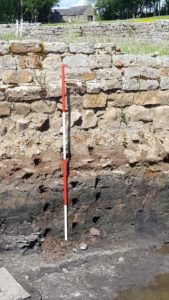
New Output: Unique chemical parameters and microbial activity lead to increased archaeological preservation
Orr, C.H., Williams, R., Halldórsdóttir, H.H. et al. Unique chemical parameters and microbial activity lead to increased archaeological preservation at the Roman frontier site of Vindolanda, UK. Sci Rep 11, 15837 (2021). https://doi.org/10.1038/s41598-021-94853-7
Published: 04 August 2021
Abstract: Waterlogged burial conditions impact upon artefact preservation. One major determinant of preservation is presence and behaviour of microorganisms, however, unravelling the mechanisms, especially in waterlogged conditions is challenging. In this study, we analysed elemental composition, bacterial diversity and community structure from excavation trenches at the Roman Site of Vindolanda, Northumberland, UK, using pXRF and 16S rRNA gene amplicon sequencing. Excavation trenches provide information of different occupation periods. The results indicated that microbial communities were dominated by Firmicutes, Bacteroidetes and Proteobacteria at a phylum level. Samples which also had visible vivianite presence showed that there were marked increases in Methylophilus. Methylophilus might be associated with favourable preservation in these anaerobic conditions. More research is needed to clearly link the presence of Methylophilus with vivianite production. The study emphasises the need for further integration of chemical and microbiome approaches, especially in good preservation areas, to explore microbial and chemical degradation mechanisms.
New paper: Heterogeneity enables coexistence of native and invasive aquatic plants
Lecturer in Environmental Science (2 Posts)
Our Department is advertising for two permanent positions of lecturer in environmental science. The newly appointed lecturers have an opportunity to take a leading role in our Earth, Ecology and Environment research collective and bring their own research and/or consultancy expertise.
The job ad can be found following the two links below:
Job.ac.uk
If you would like to discuss how your research could fit within the Earth, Ecology and Environment research collective – please get in touch with Ambroise a.baker@tees.ac.uk.


